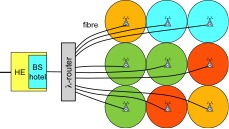Networks
Research themes
Dynamic resource allocation and user association in pico-cell networks
| Summary |
A powerful approach to expand the capacity of networks and support further growth within the confinements of existing wireless spectrum is to deploy pico cells so as to cover areas with high traffic density (hot spots), connected to a high-capacity fiber-optical backhaul network. A crucial challenge in such networks is to optimize the performance and minimize the energy usage in the presence of highly dynamic user populations with diverse traffic characteristics and quality-of-service requirements. Dynamic feeding of picocells by flexible routing of radio-over-fibre signals is foreseen as the enabling technology to address this challenge. Key decisions are which users should be associated with which access points, which access points to activate and which ones to power off, and which frequencies to allocate to the various active access points, giving rise to complex graph coloring problems. The goal of this project is to develop efficient algorithms for assigning users and allocating power and spectral resources to the various pico cells in such networks. |
| Supervisors | Sem Borst (TU/e), Ton Koonen (TU/e), Gerhard Woeginger (TU/e) |
| PhD Student | Bart Post |
| Location | Eindhoven University of Technology (TU/e) |

 Wireless networks have experienced immense growth in traffic loads over the last few years fueled by the rapid proliferation of smartphones, tablet computers and many bandwidth-hungry applications. With projections of a booming growth in video streaming, the sharp rise in traffic volumes is widely forecast to continue or even accelerate (doubling annually, implying a 1000-fold increase over the next decade), and put yet greater strain on the capacity of wireless networks.
Wireless networks have experienced immense growth in traffic loads over the last few years fueled by the rapid proliferation of smartphones, tablet computers and many bandwidth-hungry applications. With projections of a booming growth in video streaming, the sharp rise in traffic volumes is widely forecast to continue or even accelerate (doubling annually, implying a 1000-fold increase over the next decade), and put yet greater strain on the capacity of wireless networks.